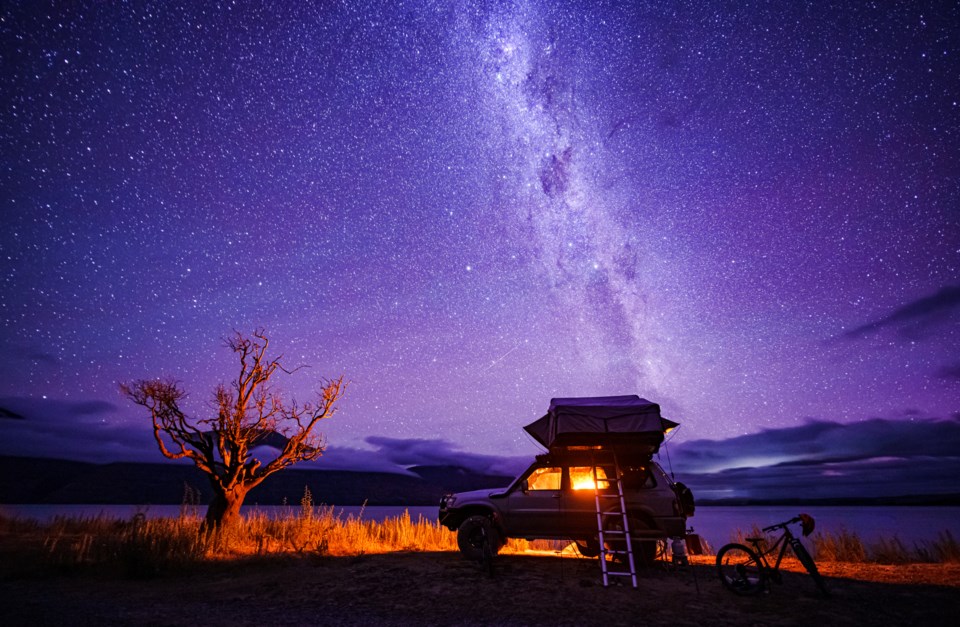Campground parking, commonly referred to as “car camping,” is a cherished summer activity in Canada. It’s easy enough to bring the kids, the baby, the dog, and if you have enough storage on your vehicle, a litany of summer toys including (but not limited to) paddleboards, kayaks, mountain bikes and bocce ball sets.
Depending on the campground and time of year, car camping comes with the caveat of having dozens if not hundreds of other campers around you. For those seeking more of a wilderness experience, the hordes of people, RVs and screaming kids found in Provincial and private campgrounds can be somewhat of a turnoff.
The vastness of Canada does give you options, though. Smaller recreational sites or “rec sites” are much more remote, with access often requiring you to drive on gravel forestry roads. The facilities at rec sites are far more basic. There are no showers or potable water taps and toilets are usually just a humble outhouse. You also have to bring everything with you (including water) and pack everything out. Rec sites are sprinkled all over B.C. and offer a much more “outdoor” camping experience for those willing to make the longer drive on rougher roads.
From here, the only option to go more remote for your weekend camping is to hike into the backcountry. This requires a different set of gear, subbing out heavy and bulky items for lightweight and compact ones. Your tent and sleeping gear need to fit in (or be strapped to) your backpack, and depending on where you want to camp, you might need a 4x4 vehicle to access the trailhead.
When you get to your spot it’s usually easy enough to get some distance from the other humans and enjoy some real wilderness. Just remember to bear-proof your food.
There’s also an option that mixes the elements of car camping and backcountry camping, loosely referred to as “overlanding.” With the rise of vehicle-based outdoor exploration in recent years, what is considered true overlanding (and what is not) has been under debate. Purist website xoverland.com describes it as follows: self-reliant adventure travel to remote destinations where the journey is the primary goal. The key words here are “remote” and “self-reliant,” but overlanding is typically thought of as off-road travel that isn’t about reaching one spot as much as it is about making it there.
Technically, you could overland and camp in a regular dome tent, but these journeys usually require you to pull off on the side of a gravel road to camp. Having a sleeping system attached to your 4x4 vehicle is a lot more comfortable and convenient. This is a sizable investment, especially if you’re getting into the world of rooftop tents (RTT), truck campers and Sprinter vans.
I’m not sure if overlanding is my thing yet, but I have a trip planned on Northern Vancouver Island in late summer that will be a good test. I have my truck, which in order to make sleep-ready (without blowing the entire summer budget), needs a rooftop tent mounted on it. The RTT just needs to mount to a bed rack (which bridges the sides of my pickup bed with hefty steel bars) and off we go on an adventure.
It might sound simple, and if you’re not picky, it probably is. But I tend to overanalyze these things for the perfect optimization, which results in hours of research and decision paralysis before finally pulling the trigger on a purchase.
Let’s start with the RTT. They come in various styles, but most are a choice between softshell (usually bigger and more comfortable) and hardshell. I know I want a hardshell style because 1) I want it to set up and tear down quickly, and 2) I want the best possible aerodynamics for fuel economy. Those parameters narrow down the field substantially.
For the rack, I need something that’s going to fit on the six-foot-long bed on my Tacoma and not have it look weird, so the more common shorter racks for Tacoma five-foot beds are not an option. The height of the racks will determine how high the tent sits, so if I want decent aerodynamics I need to keep the rack height at about 12 inches.
I also want to maintain access to my truck bed and perhaps even fit a couple of large, 29-inch-wheeled mountain bikes over the tailgate, but I’ve realized this quickly starts to get incompatible. For an optimized RTT setup, you have to balance your priorities of aerodynamics, bed storage versatility and physical fitment of the RTT itself. Some of these hardshell RTTs are between 83 and 92 inches long, so if you want to keep them at the level of your truck’s roofline you’ll have up to a foot of the RTT hanging off the back of your truck. That’s going to look bad, park bad and be a general pain when you’re walking around the back of the truck. Options exist to have a side-opening hardshell RTT, which trade shorter length with more height when closed, which is currently the most optimized solution I can find.
Better pull the trigger on all this before the summer is over. Stay tuned as this upgraded setup takes shape.
Vince Shuley is spending a lot of time on Facebook Marketplace to equip his truck. For questions, comments or suggestions for The Outsider, email [email protected] or Instagram @whis_vince.




